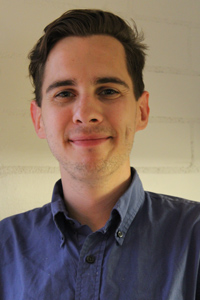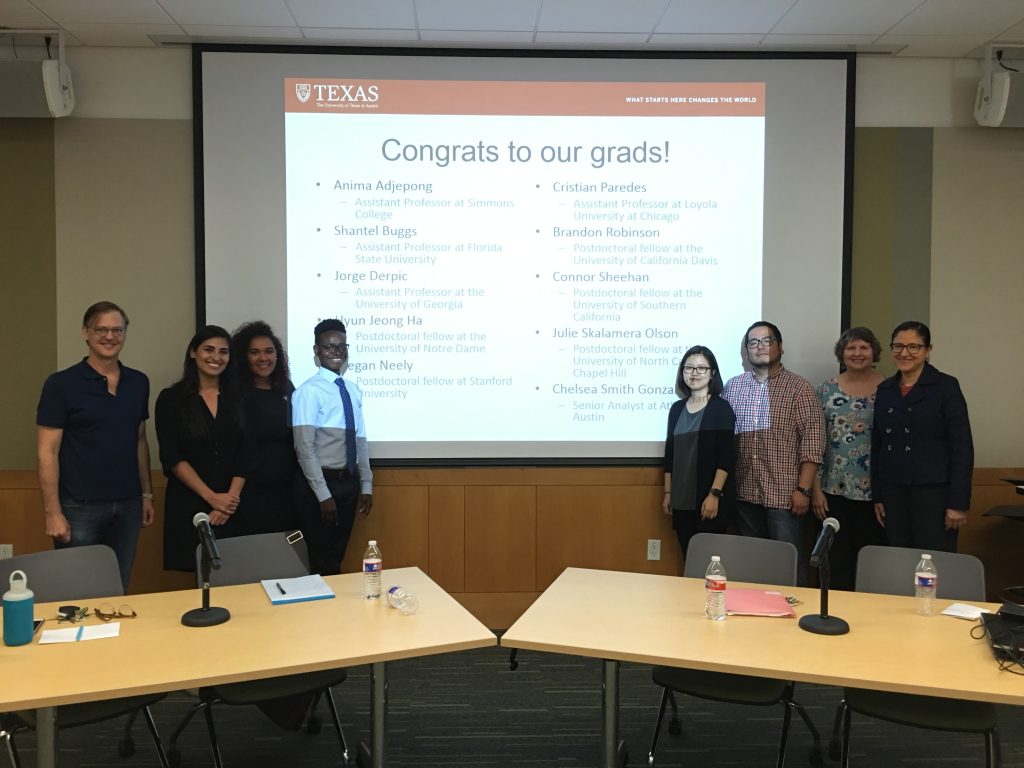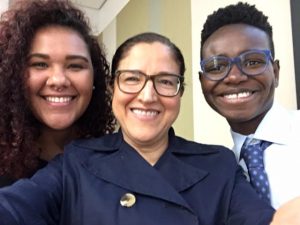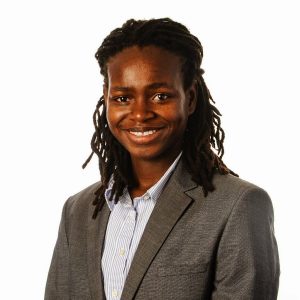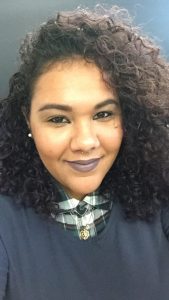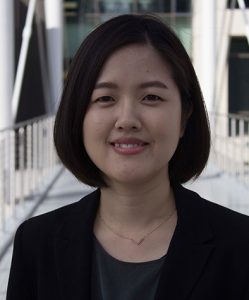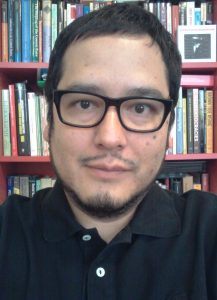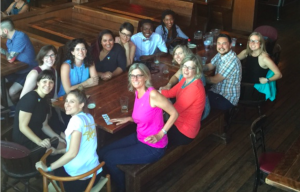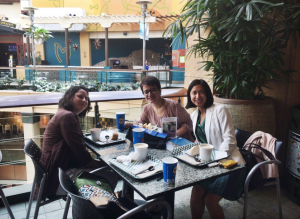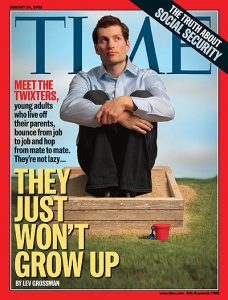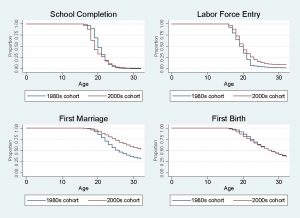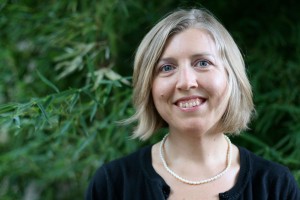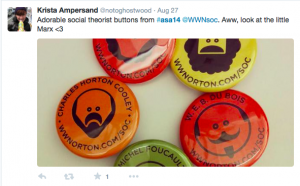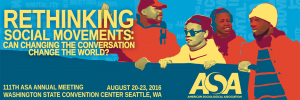
With papers that engage the theme of “Rethinking Social Movements” in a variety of ways, UT-Austin Sociology will be a huge presence in Seattle this year! Find more presentations and events of interest in the ASA Program here.
Elizabeth Ackert, Robert Wayne Ressler, Arya Ansari, Lilla Pivnick, Robert Crosnoe
August 23rd, 10:30 – 11:30am
Mexican-origin Participation in Pre-kindergarten Care and Education: The Role of Family Necessity
Children of Mexican origin exhibit gaps in academic performance with their non-Latino peers throughout the educational pipeline, with disparities emerging even prior to kindergarten. Although early formal childcare and education hold great promise in attenuating these gaps, children of Mexican origin are less likely to attend pre-kindergarten (pre-K) programs than their peers. This study uses the Early Childhood Longitudinal Study-Birth Cohort to evaluate selection into formal early childcare and education among 4 year-old children from Mexican-origin, white, and black households. We evaluate how factors related to “family necessity,” including children’s need for educational enrichment and parents’ need for childcare, impact the selection of children of Mexican origin into non-parental care and formal early care and education. Results indicate that factors related to both child and parental necessity are associated with selection into non-parental care and formal care and education for children of Mexican origin, as well as for their peers. Among children in Mexican-origin, white, and black households, the likelihood of enrolling in pre-K is higher among children that have high mental skills, among children with working mothers, and among children in households where a father is absent. White and black children that have a higher number of siblings are less likely to attend pre-K, but number of siblings is not strongly related to pre-K attendance for Mexican-origin children. Even though family necessity is predictive of pre-K attendance for children of Mexican origin, these households have lower observed levels of family necessity than white households.
Anima Adjepong
August 20th, 10:30am – 12:10pm
All Lives Matter? On the Racial Politics of Black African Immigrants to the United States
The goal of this paper is to examine the extent to which tension exists between these groups from the perspective of one community of West African immigrants in Houston, Texas. I use the ongoing protests and discourses of Black Lives Matter as a way of delving into the antipathies and sympathies of this black immigrant community whit regard to the Black Lives Matter movement and as black (African) Americans more generally. This research offers a way to understand how a community of black African immigrants aligns with or opposes dominant black American politics and how they in turn articulate the particularities of their black identities. As such, this paper offers important insights into the diversity of blackness and provides a better understanding of the perceived tensions between black Americans and black Africans.
Jennifer March Augustine, Kate C. Prickett, Rachel Tolbert Kimbro
August 20th, 10:30am – 12:10pm
Health-related Parenting among U.S. Families and Young Children’s Physical Health
Parenting is comprised of a constellation of behaviors, yet investigations of the link between parenting and children’s health typically focus on singular behaviors. Thus, the patterns of health-related parenting among U.S. families, associations between these patterns and young children’s physical health, and prevalence of such patterns among different socioeconomic groups remain unknown. Applying latent class analysis to the Early Childhood Longitudinal Study-Birth Cohort (n=8,550), we find six patterns of parenting that oftentimes include advantageous and adverse behaviors. Children with high levels of screen time had the worst overall health; children in the class characterized by highest consumptions of food and amounts of outdoor play had highest odds of obesity. Children of less educated mothers and Black children were more likely to belong to both classes than the class associated with the best child health, but membership was not distinguished by Hispanicity and only by family income for the latter class.
Jennifer March Augustine, Julie Skalamera Olson, Robert Crosnoe
August 23rd, 2:30 – 4:10pm
Concentrated Poverty in U.S. Schools and Adolescents’ Risk of Being Overweight
The growing concentration of students from low-income families in schools does not only have consequences for academic disparities and educational inequality. Attending a high-poverty school may also negatively affect students’ physical health. Building on the school effects literature and drawing on data from the National Longitudinal Study of Adolescent to Adult Health (Add Health; n = 18,924), we used multi-level modeling techniques to reveal that the concentration of students from low-income families in U.S. secondary schools was associated with students’ individual likelihood of being overweight, net of their own background characteristics and many other factors selecting them into their schools. The primary mediator of this association was the concentration of other overweight students in the school, a mediational pathway that partly reflected unhealthy dieting norms in schools with many overweight students but was not related to the prevalence of obesogenic behaviors, school norms around body size, and social stigma around body size in those schools.
Kate Henley Averett
August 21st, 8:30am – 10:10 am
Constructing the Homeschooled Child: Childhood Gender and Sexuality in the Homeschooling Movement(s)
Though it is commonly understood as a practice restricted to fundamentalist Christians, homeschooling in the United States has, throughout its history, been a container for many differing ideological stances and (non-)religious groups. This paper looks at the question of how childhood is constructed in two different arms of the larger homeschooling movement: conservative Christian homeschooling, and those that use the progressive practice of unschooling, with specific attention to how gender and sexuality are at play in discursively constructing “the homeschooled child.” Using data from field notes collected at five different homeschooling conferences and conventions in Texas from 2013-2015, the author argues that “the homeschooling community,” “the homeschooling family,” and “the homeschooled child” are constructed very differently by these two groups. For religious conservatives, children are seen as innocent and in need of protection from a sexually liberal culture, whereas for progressive unschoolers, children are seen as autonomous beings who should be allowed to explore their own place in a gendered and sexual world. These differing constructions of childhood lead to very different parenting styles, with implications for children’s development of their own bodily autonomy.
Anna Veronica Banchik
August 20th, 2:30 – 4:10pm
Like Mother, Like Daughter: Household Labor, Business Inheritance, and Women’s Self-employment in Zacatecas, Mexico
Drawing on interviews with 31 self-employed women in the state of Zacatecas, Mexico, this paper illustrates the processes by which daughters are transferred skills, resources, and economic activities from their mothers. My research shows that daughters enter into self-employment through a process I refer to as “parallel inheritance” whereby daughters participate in their mothers’ businesses from a young age as part of their gendered household responsibilities. Given limited formal employment opportunities, daughters take on their mothers’ businesses despite their advanced educational credentials. I adopt anthropologist Deniz Kandiyoti’s (1988) concept of the “patriarchal bargain” to highlight the reliance of mothers on their daughters’ labor in their households and businesses. Mothers encourage their daughters to continue and increase their participation in “family businesses” by reminding them of their responsibilities as “good daughters” and by invoking the importance of family duty and legacy. In turn, daughters express feelings of ambivalence and burden towards the enterprises they have inherited. This paper builds on feminist and economic sociological literatures by shedding light on the ways by which women’s self-employed practices shape and are shaped by their negotiations with household members.
Laura Barberena, Phillip Vargas, Michael P. Young
August 23rd, 8:30 – 9:30am
“Bad DREAMers” and the Radicalization of the U.S. Immigrant Rights Movement
Liberal elites conceived of DREAMers as the “innocents” of the 12 million undocumented immigrants in the United States. All collective identities are in some sense imagined, but the DREAMers were quite literally conjured up by a piece of proposed legislation—the Development, Relief, and Education for Alien Minors Act or DREAM ACT. This paper is about the radical undocumented youth who struggled for recognition and autonomy within a movement built on their reification as dreamers of the American dream. Drawing on over 50 interviews, years of participatory observation, and the video archives of the National Immigrant Youth Alliance, this paper follows key actors and their collective actions from 2009 to the present. From their perspective and through their escalating protests, we sketch how the erstwhile “innocents” of the movement became its “bad-ass” radicals. We conclude with a discussion of the social forces driving social movement radicalization.
Amanda Bosky
August 23rd, 10:30am – 11:30am
Skills in Adolescence, Occupation, and Disability at Midlife
With life expectancy increasing and access to retirement benefits decreasing, the ability to participate in the labor force is vital in today’s society. At midlife, individuals are still of working age and may be particularly vulnerable to the financial and psychosocial stresses of labor force detachment. Using the newest wave of High School and Beyond (1980), this study investigates how skills that individuals possess in adolescence relate to being out of the labor force due to disability at midlife. Results indicate that math skills and an internal locus of control in adolescence are protective against being out of the labor force due to disability at midlife. These associations are partially explained by educational and occupational advantages across the life course, but skills in adolescence remain independently protective of labor force participation at midlife. This study highlights the importance of viewing later-life outcomes as a consequence of earlier experiences and taking a longer view of the life course origins of adult outcomes.
Amanda Bosky and John Robert Warren
August 23rd, 10:30 – 11:30am
Skills in Adolescence, Occupation, and Disability at Midlife
With life expectancy increasing and access to retirement benefits decreasing, the ability to participate in the labor force is vital in today’s society. At midlife, individuals are still of working age and may be particularly vulnerable to the financial and psychosocial stresses of labor force detachment. Using the newest wave of High School and Beyond (1980), this study investigates how skills that individuals possess in adolescence relate to being out of the labor force due to disability at midlife. Results indicate that math skills and an internal locus of control in adolescence are protective against being out of the labor force due to disability at midlife. These associations are partially explained by educational and occupational advantages across the life course, but skills in adolescence remain independently protective of labor force participation at midlife. This study highlights the importance of viewing later-life outcomes as a consequence of earlier experiences and taking a longer view of the life course origins of adult outcomes.
Sarah Brayne
August 21st, 10:30am – 12:10pm
Police Conflict Over the Use of Big Data
In this paper, I draw on fieldwork within a large urban police department to understand how the police themselves respond to the adoption of “big data” analytics. Despite media and social scientific portrayals of law enforcement as an organization with a voracious appetite for data-driven surveillance, I suggest the adoption of advanced analytics and new surveillant technologies is actually frequently contested within law enforcement, ultimately serving to entrench old divisions and create new distinctions within the department. I find levels of enthusiasm for big data varies both by position in the organizational hierarchy and by function in the department. I distinguish between six related, but analytically distinct grievances raised by those opposed to the adoption of data-driven practices within the department. First, police object to increases in their own surveillance associated with new technologies. Second, the emphasis placed on data-driven practices devalues officers’ local, experiential knowledge in favor of abstracted data. Third, the inscrutability of algorithms impedes officer buy-in to predictive analytics. Fourth, the adoption of big data analytics exacerbates friction between pre-existing divisions in the Department including local authorities/federal agencies, sworn officers/civilian employees, managers/street-level workers, and rookies/veterans. Fifth, interviewees in law enforcement raised privacy concerns about large-scale changes in surveillance practices. Finally, individuals raised questions about the efficacy or unanticipated consequences of specific analytic technologies. This research sheds light on new dimensions of surveillance in the age of big data and changes the way we understand data-driven policing, quantification, organizational practice, and inequality.
Shantel Gabrieal Buggs
August 23rd, 10:30am – 12:10pm
Exploring the Influence of Black Lives Matter on Mixed-Race Women’s Discourses of Race and Racism
This paper explores the discourses and logics that self-identified multiracial and multiethnic women online daters in Texas utilize to explain their own responses to social justice movements around race and racism in the United States. These women utilize stances on the issues that movements such as Black Lives Matter address as a means articulating their own political views, as well as to vet potential dating partners. The language around, and produced by, contemporary social movements in terms of mainstream media coverage and social media campaigns influence the ways in which these women discuss race, gender, and racism. The goal of this paper is to shed light on how mixed-race women are navigating racial politics on an interpersonal level during a time where U.S. media and popular culture is especially focused on issues of racism and state-sanctioned violence.
Ben Carrington
August 21st, 12:30 – 2:10pm
The Two Cultures of Culture: Stuart Hall’s missing legacy from American cultural sociology
On February 10th 2014, Stuart Hall passed away. Hall was one of the world’s leading cultural theorists. But Hall’s groundbreaking sociological approach remains directly at odds with what passes for sociological inquiry as practiced by many American sociologists. Taking its title from C.P. Snow’s famous lecture on the “The Two Cultures and the Scientific Revolution”, this paper, (i) traces the “two cultures” of sociological work on culture, the British Cultural Studies and American sociology of culture traditions, exploring how the object of inquiry has come to be framed in such diametrically opposed ways by each, (ii) I specifically compare and contrast the approaches and distinctive contributions of Hall and Patterson, using Patterson’s recent edited collection “Cultural Matrix: Understanding Black Youth” and Hall’s earlier texts “Resistance Through Rituals: Youth Subcultures in Post-War Britain” and “Policing the Crisis: Mugging, the State, and Law and Order” to help highlight and exemplify the different ways of understanding culture, identity, meaning and the role of the state, found within each author’s framework and (iii) I challenge recent arguments concerning the value of a “transdisciplinary” approach to the study of culture that some have argued is a “new” way forward for the study of culture. Instead, I suggest that a less myopic (and ultimately more meaningful and informed) American sociology of culture is possible if the five decades worth of intellectual contributions from sociologists such as Hall, and others, are acknowledged and taken more seriously by American sociology of culture scholars.
Jamie M. Carroll and Eric Grodsky
August 23rd, 12:30 – 2:10pm
Tracking Health Inequalities in Midlife: The Role of Curriculum Stratification
Although the link between education and health outcomes is well established, how variation in educational experiences shapes health across the life course is less often studied. This paper examines how on aspect of the process of schooling, high school curriculum stratification, is related to self-reported health status and physical functioning at midlife. We combine literatures on the link between educational attainment and health and on curriculum stratification to understand if curriculum stratification is related to long-term health outcomes, and if this association operates through skill development, postsecondary attendance and attainment and occupational characteristics. We find that, controlling on background, adolescent health and school-level characteristics, curriculum stratification is associated with health at midlife. Specifically, taking higher levels of math increases self-reported health and physical functioning at midlife. This association partially operates through the pathways into adulthood, through experiences in college and the labor force, but an independent association between curriculum stratification and self-reported health remains when considering these mechanisms. Our findings have implications for both educational policy and education and health research.
Shih-Yi Chao
August 22nd, 10:30 – 11:30am
Working Conditions and Marital Dissolution
The vast demographic changes in families and workplace in the U.S. accompany with increasing demands of work and family involvement. Understanding the relationship between work and family can reveal how the new economy competes and negotiates with family, and what people pay to sustain the system. Applying JD-R model to NLSY79 with discrete-time hazard model, this study discusses how specific dimensions of working conditions influence the risk of divorce. The results show a full time job lower men’s divorce risk they encounter. In contrast, longer working hours influence women’s marital stability. Women who work at rotated shift suffer from higher risk of divorce than those at fixed shift. Personal income has no significant influence on men’s divorce risk, while women’s personal income is positively related to the risk of divorce. In addition, fringe benefits cannot effectively predict the risk of divorce for men, whereas paid sick days reduce women’s divorce risk, and health insurance facilitates women’s willing to get divorced. In summary, the influence of working conditions on divorce depends on the image of conventional gender division of labor in household. Although women’s employment keep going up, and gender equality spread widely, conventional breadwinner-homemaker family seems not be challenged for couples of NLSY79 cohort, as well as women’s disadvantages in the labor market, which forces women to stay in marriage.
Wenhong Chen, Seokho Lee, Kang Hui Baek
August 23rd, 8:30 – 9:30am
Hybrid: Organizational Membership and Protest Participation in the Age of Social Media and Financial Hardship
Do formal brick-and-mortar civic groups remain relevant as social media enable connective action of self-motivated, self-joining individuals? Adding to the relatively small number of studies that draw on national representative survey data, this research offers one of the first systematic analyses of hybrid organizational membership and protest participation. Results underscore that hybrid organizational membership matters most to protest participation, while neither membership in traditional civic groups nor membership in social-media-only groups is enough. Mobilization exposure, especially via emails, text messages, and SNSs, is significantly associated with protest participation. Grievances, rather than individual resources, are significantly related to protest participation in the U.S. with growing social inequalities. Theoretical and practical implications are discussed.
Wenhong Chen, Fangjing Tu, Pei Zheng
August 23rd, 2:30 – 3:30pm
When Risk Society Meets a Transnational Networked Public Sphere: An Analysis of PM2.5 Twitter Network
Drawing on Twitter data and publicly accessible government document and media reports, this research integrates Beck’s risk society theory with digital media theories to examine the mediated process of risk definition and assessment of PM2.5 (particulate matters with a diameter less than 2.5 micrometers) in a networked public sphere. Network and content analysis of a PM2.5 Twitter network shows that elite – political or professional – remained the most powerful producers of risk definition. Media played a key role yet faced challenges from diverse actors who participated in information dissemination. Laypersons, while peripheral, actively interacted with elite and media. The blurring geographic boundary in the PM2.5 Twitter network revealed an emerging transnational public sphere, which, however, remained segregated by language. This research advances a layered understanding of contingent, paradoxical impact of media in a risk society.
Thatcher Combs
August 20th, 10:30am — 12:10pm
Transcending the Binary: Gay Men and Their Relationships with Transgender Men
Since the fight for marriage equality has now come to a close, many have wondered how the LGBT movement will move forward. Increasingly, the movement’s attention is turning to addressing the needs of the transgender community, which have been historically relegated to an afterthought. As transgender people and the transgender movement continue to gain national attention investigating how “gender normals” view transgender people as friends and possible sexual partners is important. I conducted in-depth interviews with gay men in San Francisco and asked: 1) Do gay cisgender men view transgender men as friends and as potential sexual partners? 2) How do gay men manage their identity as gay men when they have been with transgender men in romantic relationships or in sexual encounters? I focus on how gay cisgender men’s gender identity and sexual orientation influence their choice of friends and lovers. Thus, this project examines how gay men’s discourses on gender and sexuality promote the continued exclusion of transgender men from personal and political networks. I argue that examining how gay cisgender men view transgender men illuminates some of the barriers that can affect the LGBT movement’s future trajectory. Furthermore, this study provides a new lens on the ways in which members of the LGBT community intermingle socially and sexually with each other. In doing so, this study highlights the ways in which gender, sex, and sexuality are inherently intertwined and inseparable.
Elizabeth Cozzolino
August 20th, 8:30 – 9:30am
Deadbeat Dads or Debtor’s Prison? Jailing for Child Support Nonpayment
On April 7, 2015 in North Charleston, S.C., Walter Scott was shot eight times in the back as he fled from a routine traffic stop. According to an attorney for the family, Mr. Scott fled because he owed child support arrears and did not want these arrears to send him back to jail (Schmidt & Apuzzo 2015). This incident points to the understudied connection between child support enforcement and the criminal justice system. Putting non-custodial parents in jail for failure to pay child support is one of the many tools of child support enforcement that the state possesses. But little is known about how frequently this tactic is used, against whom, and what the ramifications are (Patterson 2008). Using data from the Fragile Families and Child Wellbeing Study (FFCW), this working paper explores who goes to jail for child support nonpayment.
Jorge Derpic
August 22nd, 4:30 – 5:30pm
The Entrance to the Marvelous City: Cable Car System, Ethnicity, and Labor in a Bolivian City
In 2014, the Bolivian national government inaugurated a massive cable car system between the cities of La Paz and El Alto. The new transportation service generated a sense of pride among citizens who in general received it positively. However, it also opened the door for renewed strategies of ethnic differentiation and boundaries-setting among neighbors, public transportation carriers and street vendors. Those who attempted to settle or work in some of the surrounding areas to the stations confronted residents’ mobilizations, or physical and in some cases violent clashes against competitors. This paper seeks to analyze this phenomenon by focusing on how the inauguration of the cable car at one station of El Alto reshaped the perception of residents about their areas of livelihood; how it transformed the relationship between residents, on one side, and street-vendors and public transportation carriers on the other; and how it exacerbated the competition between these same bus drivers. Through interviews, news stories and participant observation, this study argues that current ethnic distinctions are produced by a structural context marked by a colonial history of discrimination against indigenous populations, combined with three decades of structural adjustment reforms. The ‘new’, clearly identified, undesirable populations in these urban environments, are those of indigenous origins who make a living in the informal markets.
Daniel G. Fridman and Pilar Zazueta
August 23rd, 10:30 – 11:30am
The Sovereign and the Victim: Comparing Consumer Policies in Mexico and Argentina in the 1970s
In the 1970s, the Mexican and Argentine governments embarked in simultaneous efforts to revamp their policies towards consumers. While public concerns about consumers had been present in both countries before that time, the consumer reached at the end of the 1970s a centrality in political discourse rarely discussed in the literature on consumption in Latin America. This article compares how the Mexican and Argentine states treated consumers in Argentina and Mexico in the late 1970s and early 1980s. In both countries, official publications for consumers encouraged people to recognize their consumer condition, to realize that, whether they knew it or not, they were consumers, and their duty was to become better at it. Both governments recruited consumers in the fight against inflation, and demanded that citizens acquire expertise about household economics as well as nutrition and health. Consuming was becoming a craft that required knowledge and continued training, particularly for children, who were having increasing weight in the consumer decisions of the household. There were, however, substantial differences between Argentina and Mexico. While the Mexican campaigns remained suspicious of free-markets and addressed consumers without erasing class and inequality, the Argentine campaigns saw the consumer as the guarantor of a new order based on the market as well as a new identity that would replace social classes. While Mexican officials framed the consumer as a victim of injustices, Argentine officials focused on the consumer as the sovereign and owner of the market.
Carmen Marie Gutierrez
August 23rd, 2:30 – 4:10pm
Health Care Reform and the Criminal Justice Population
The Affordable Care Act offers a new opportunity to examine the health of individuals involved in the criminal justice system. Over two-thirds of the 2.2 million adults incarcerated in jails and prisons across the U.S. have a chronic medical condition or infectious disease, and 70 to 80% meet the criteria for having either a mental health or substance use disorder. With a constitutional right to health care, most inmates with such physical, mental, and behavioral health problems receive prescription medication or some other form of medical treatment behind bars, but the availability of health care typically ends at the gates of correctional facilities for former inmates who often become uninsured and encounter exacerbated health issues upon their reentry. Recent changes in U.S. health policy, however, provide the criminal justice population with an improved chance for health maintenance. Whereas previous state and federal programs have offered assistance for insurance to adults on the basis of disability, as well as to low-income adults who are pregnant or custodial parents to dependent children, key features of the health reform offer new pathways for subsidized insurance coverage to low-income, childless adults for the first time in the nation’s history. Such shifts in policy may have a particularly significant impact for men formerly involved with the criminal justice system who make up over one-third of the 16 million Americans newly eligible for Medicaid in 2014. How do changes in eligibility for subsidized health insurance shape health care access among men involved in the criminal justice system?
Katherine Hill
August 22nd, 4:30 – 5:30pm
Sweet and Sour: Ethnic Networks and Inequality in a Chinese Restaurant
This study examines the experiences of Asian immigrants working in Asian restaurants to understand how ethnicity and race shapes their social interactions and social inequality inside their places of work. Using interviews with Asian immigrants working in Asian restaurants and three months of participant observation in a Chinese restaurant, I consider how immigrants working in an immigrant-owned business understand socioeconomic attainment, how social capital functions in ethnic networks, and how race, ethnicity, and gender shape workers’ experiences in family owned restaurants. I argue that the success of Asian immigrant businesses is not a result of Asian culture; rather, Asian restaurant owners may exploit both co-ethnic and other racial-ethnic workers to benefit their own socioeconomic mobility. Ethnic network members provide support to each other in a project of “ethnic uplift” to gain socioeconomic mobility while differentiating their group from those deemed lower on the ethnic-racial hierarchy. Within ethnic networks, co-ethnic exploitation occurs when individuals attempt to move up the socio-economic ladder in a solitary project of racial and socioeconomic uplift.
Yasmiyn Irizarry
August 21st, 2:30 – 4:10pm
On Track or Derailed? Race, Advanced Math Course Taking, and the Transition to High School
In order for students to reach the highest echelon of high school mathematics, they must not only establish an advanced math course-taking trajectory, but also sustain this trajectory over multiple years. Unfortunately, this early start makes advanced math trajectories susceptible to curricular disruptions unique to the middle to high school transition (Loveless 2008). Using data from the High School Longitudinal Study of 2009 (HSLS), I examine racial/ethnic gaps in advanced math course taking for first-time ninth graders attending public schools. Results show that eighth grade math track both mediates and moderates the relationship between race/ethnicity and advanced math course taking. For example, black-white and nonwhite Latinas/o-white math course-taking gaps only hold among student on the advanced math track, whiles the gap between Southeast Asian and white students is most pronounced among students not on the advanced math track. Although some observed racial/ethnic differences were explained by student background (gender and SES) and course grade, significant racial/ethnic differences remain. Additional analyses also examine the importance of math skills. Overall, findings demonstrate that the transition to high school disrupts math trajectories, such that even strong academic performance may not be enough to remain on the advanced math track. They also highlight significant racial/ethnic differences in vulnerability to downward shifts, with black and nonwhite Latina/o students having a significantly higher risk, and East and South Asian students significantly lower risk than whites. These racialized barriers and benefits have important consequences for course-taking trajectories, achievement gaps, and the racial/ethnic underrepresentation in the STEM pipeline.
Daniel Jaster
August 22nd, 2:30 – 3:30pm
For a Broader Understanding of the Double Movement: Reforming the Rural United States, 1860-1920
Karl Polanyi’s double movement concept has increasingly been utilized to describe and explain instances of community resistance to neoliberalism across the globe. However, this concept has almost exclusively been applied to resistance to economic reforms. In contrast, I argue that the fundamental feature of Polanyi’s double movement is the dialectic of disembedding and rembedding. Therefore, this concept can be applied to cultural as well as economic conflicts. I illustrate this argument with an analysis of a cultural double movement that occurred in rural Midwestern America in the early 20th century illustrates this point. Attempts by the urban middle-classes to disembed the rural economy, community, and cultural practices from the local context and re-embed them in cosmopolitanism and urbanism were met with significant resistance. Farmers chastised comments that rural life was backwards, organized campaigns against school and church consolidation, and worked to ensure that changes would retain as much local influence as possible. Though they ultimately failed, this resistance illustrated that rural communities would not quietly accept changes forced on them. This rethinking of the double movement gives scholars a new way to look at past analyses of social change for other instances of this dynamic, as well as opening discussions about how it can fail.
Betsabeth Monica Lugo
August 21st, 8:30 – 9:30am
What Does it Mean to Return Home? Mexican Women Narratives of Hope and Uncertainty
This paper examines what it means to return to Mexico for Mexican women living in the Dallas metropolitan area without papers. While the fear and distress caused by the possibility of being deported are common features of life among undocumented immigrants, not all undocumented immigrants experience the same kind of anxiety and apprehension about the possibility of returning home. Drawing on qualitative interviews with 43 undocumented Mexican women, I examine the factors that shape the women’s subjective concerns about returning to Mexico and how they use narratives of hope and uncertainty to articulate two main concerns: providing educational opportunities to their children and protecting their children from violence. I pay particular attention to how Mexican women articulate their aspirational longings and how these are shaped by the condition of illegality.
Chandra Muller, Evangeleen Pattison, Robert Reynolds, Eric Grodsky
August 22nd, 4:30 – 6:10pm
Migration within the United States: Education and Skills for Pursuing the American Dream
The U.S. internal migration rate is among the highest in the advanced world and the freedom to move is central to the American Dream. The decision to migrate has long been linked to personality characteristics like determination, hard work, and entrepreneurialism. Yet, spatial inequality is on the rise, with areas of greater economic opportunities—those with a concentration of educated workers, or innovation areas—growing faster. This study uses the High School and Beyond 1980 sophomore cohort and its 2014 midlife follow-up to investigate how cognitive and non-cognitive skills, and education predict who moves during adulthood and who lives in an innovation area at midlife. Findings indicate that cognitive and non-cognitive skills, advanced mathematics high school coursework, and bachelor’s degree attainment predict who moves by midlife. In contrast, only non-cognitive skills predict who moves longer distances. Earning a college degree and better cognitive skills predict who resides in an innovation area at midlife. Implications for stratification and growing inequality are discussed.
Megan Neely
August 22nd, 2:30 – 4:10pm
Financialization and the Patrimonial Firm
In a study of the U.S. hedge fund industry, I examine how racialized, patrimonial allegiances restrict access to financial rewards. The top incomes in this industry make it a relevant case for studying rising income inequality in the twenty-first century. Examining alternatives to large bureaucracies within finance uncovers a counter-movement among anti-bureaucratic firms directed towards the institutionalization of this sector. I extend theories of patrimonialism to understand industry dynamics that restrict access to opportunities, rewards, and resources. Using data from forty-four in-depth interviews, field observations, and secondary source materials, I investigate the hiring, grooming, and seeding processes within and among firms that enable elites to maintain monopolies over financial resources. I contend that the industry reveals patrimonial enterprises present despite the state’s deliberate retrenchment in the neoliberal era.
Pamela Jane Neumann
August 21st, 8:30 – 10:10am
Legitimacy on Trial: Transnational Governance, Local Politics, and the Battle over Gender Violence Law in Nicaragua
Why would a government approve a path-breaking new law against gender-based violence and then subsequently dismantle it? To address this question, this paper examines the process by which Nicaragua came to pass its most recent comprehensive law concerning violence against women (Law 779) in 2012, and the contentious politics that led to its unraveling over the next two years. Drawing on ten months of ethnographic fieldwork and archival research, this paper adopts a transnational feminist theoretical lens in order to analyze why the Nicaraguan state embraced a women’s right to a life free of violence in one moment, but then later intentionally undermined its own previous actions. To explain why Law 779 was initially passed and later weakened, I make a twofold argument. First, I suggest that Law 779 was passed in order to keep pace with regional legal trends in Latin America concerning violence against women. Second, I contend that the subsequent derailment of Law 779 is due to (1) the Ortega regime’s alliance with conservative religious groups, and (2) the state’s interest in preserving Nicaragua’s reputation as the so-called “safest country in Central America.” As a result, patriarchal interests and ideologies remain firmly entrenched in Nicaragua’s political institutions. These findings have implications for our understandings of state legitimacy, global governance, and transnational feminist advocacy.
Julie Skalamera Olson
August 20th, 4:30 – 5:30pm
Moving Up, Feeling Down: Socioemotional Health during the Transition into College
Moving from high school to college is a critical juncture in socioemotional health, and how young people fare likely depends on their academic settings and experiences. To examine variation in trajectories of depressive symptomatology across the transition from high school into college, this study applied growth mixture modeling to data from the National Longitudinal Study of Adolescent Health, which revealed multiple patterns of symptomatology over time that ranged from healthy to unhealthy. Adolescents appeared to have the healthiest trajectories when they experienced consistently competitive academic settings in high school and college. Overall, transitioning into college was a period of socioemotional vulnerability for some and well-being for others, but challenging curricula and contexts across this transition could differentiate between the two.
Emily Allen Paine, Debra Umberson, Corinne Reczek
August 22nd, 4:30 – 6:10pm
Sexing the Midlife: Women’s Experiences aross Same-sex and Different-sex Couples
We examine the experiences of women navigating sex amidst midlife transitions within same-sex and different sex long-term couples. Data from in-depth interviews with women in 18 same-sex and 18 different-sex couples were analyzed to reveal how transitions related to caregiving, health and aging work to change women’s intra- and interpersonal experiences of sex and sexuality. We extend theories of gender and sexual scripts to examine how women framed and made sense of their changing sex lives in light of larger cultural schemas of gender and sexuality. For example, lesbian women negotiated their discordance from heterosexual scripts by framing their changing sex lives as either similar to those of heterosexual long-term couples or too different to be understood through such scripts. Whereas straight women cited their alignment with the script of sexless long-term heterosexual marriages, lesbian women negotiated stigmatized heterosexist scripts of lesbian asexuality. We introduce the term of “bed work” to describe the sense of responsibility and work undertaken to keep up sexual relationships discussed by lesbian women.
Cristian Luis Paredes
August 21st, 8:30 – 9:30am
Multidimensional Ethno-racial Status in Contexts of Mestizaje: Ethno-Racial Stratification in Contemporary Peru
In this study, I define ethno-racial status as the combination of ethnic and racial characteristics simultaneously embodied by mestizos. These characteristics refer to conceptually and empirically distinct dimensions of ethno-racial status: phenotype, ancestry, and self-identification. I alternatively explain self-identification, net of phenotype and ancestry, as exposure to ethno-racial ideologies. I also argue that these dimensions should be considered together when analyzing ethno-racial inequality. Using nationally representative data of Peru, the mestizaje research setting, I examine whether there are significant ethno-racial differences in educational attainment and household possessions by phenotype, ancestry, and self-identification. I find that indigenous ancestry and darker skin colors are inversely associated with both socioeconomic outcomes. Moreover, white self-identification compared to mestizo is negatively associated with educational attainment, but positively associated with household possessions. This approach unveils ethno-racial ideologies as relevant beliefs that are instrumental in gaining socioeconomic advantages.
Evangeleen Pattison
August 23rd, 12:30 – 2:10pm
Stratification in Higher Education and BMI at Midlife: The Role of Cognitive and Non-cognitive Skills
The inverse association between bachelor’s degree completion and body mass index (BMI) is well-documented among non-Hispanic whites, particularly at midlife. That said, existing research often neglects the highly stratified nature of postsecondary schooling in the U.S. and therefore may only tell part of the story of how bachelor’s degree completion affects BMI. As higher education has transformed from an elite to a nearly universal-based system, cognitive and non-cognitive skills developed during adolescence have become increasingly important for the sorting and selection of students into higher education. They have also been linked to numerous adult health outcomes and behaviors. In the current study, we use nationally representative longitudinal data from the sophomore cohort of High School and Beyond to investigate the relationship between stratification in higher education—as reflected by institutional selectivity—and BMI at midlife, paying particular attention to the role of skills observed in adolescence in the process. Results suggest that institutional selectivity predicts BMI at midlife among women, whereas among men, that they go to college is more important than where they go. Results further suggest that skills observed during adolescence do not independently predict BMI at midlife. There is one notable exception to this rule, however, as popularity in high school independently predicts BMI at midlife among women. Accounting for skills observed in adolescence explains the protective effect of graduating from a selective college on BMI at midlife among men. In contrast, they do little to explain this relationship among women. Theoretical and policy implications are discussed.
Ruijie Peng
August 20th, 8:30 – 9:30am
Chinese and Edcuadorian Workers in China’s Construction Project: Group Interactions and the Effect on Subordination
In 2010, China reached a loan agreement with Ecuador to fund and construct Ecuador’s largest hydro-electric project. Subsequently, the Chinese state-owned construction company began its operations, bringing Chinese and Ecuadorian staff and workers together to commence work on the first project. Due to the terms of the agreement, the Ecuadorian employees, backed by a pro-labor state with a clear Labor Code, observe eight-hour work days and bear considerable protection against work encroachment. Despite active negotiation for labor rights, Ecuadorians work almost exclusively at elementary level jobs compared to their Chinese counterparts. In contrast, Chinese employees hold privileged and seemingly better-paid work positions, but they chronically over-work with virtually no power or room to negotiate better working conditions. With different labor rights provisions on the same project, how do the Chinese and Ecuadorian employees interact with and develop opinions about each other? Then how do such interactions and popular opinions influence their radically different relationships to labor rights? This essay draws on field observations and interviews to argue that both the socio-economic structure of labor and the particular ways in which these two distinct groups interact matter. The lack of individual and group interactions, the institutionalized hierarchy in workplace, and different labor rights provisions together condition the Chinese and Ecuadorian workers’ respective relationships with labor rights. This essay examines the types of hierarchies and exchanges evolved on the project, the different labor rights and protection provisions implemented, and the origins and development of the conflicting opinions of each group.
Marcos Emilio Perez
August 23rd, 8:30 – 9:30am
Becoming a Piquetero: Past, Novel and Current Routines in the Development of Activist Dispositions
Despite substantial progress in social movement research, our understanding of activism is much more elaborate with regards to the role of ideological conversion than concerning the influence of practices. In other words, we know more about how concurring with a set of ideas sustains long-term participation, than about how engaging in certain habits lead to the same outcome. In this paper I draw on a broad sociological literature, as well as on extensive ethnographic research on the unemployed worker’s movement in Argentina, to address this issue. I argue that an essential attraction of participating in this movement is the opportunity to engage in the practices associated with a respectable proletarian ethos. Through the reconstruction of past routines, the development of new habits, and the protection of practices that are perceived as endangered, some participants enjoy their involvement in the movement, despite significant personal obstacles and even occasional disagreements with their organization’s ideas. These findings suggest that research on the relation between practices and activism can complement significantly the current literature and deepen our knowledge of social movement participation.
Kate C. Prickett
August 22nd, 10:30 – 11:30am
Non-standard Work Schedules, Family Dynamics, and Mother-child Interactions During Early Childhood
The rising number of parents who work nonstandard schedules has led to a growing body of research concerned with what this trend means for children. The negative outcomes for children of parents who work nonstandard hours are thought to arise from the disruptions these schedules introduce to family life and, through this channel, parents’ abilities to follow through on their efforts to cognitively and emotionally support children’s development, particularly when children are young. Using a nationally-representative sample of two-parent families (the Early Childhood Longitudinal Study-Birth cohort, n = 3,650), this study examined whether mothers’ and their partners’ nonstandard work schedules were associated with mothers’ parenting when children were two- and four-years old. Random effects models revealed that mothers’ and their partners’ nonstandard work schedules were associated with mothers’ lower scores on measures of positive and involved parenting than mothers who worked standard daytime schedules. These associations were mediated by fathers’ lower levels of participation in cognitively-supportive parenting and greater imbalance in cognitively-supportive tasks conducted by mothers versus fathers, providing considerations for policies supporting families with diverse work schedules.
Robert Wayne Ressler, Pam Paxton, Lilla Pivnick, Kristopher Velasco, Inbar Weiss
August 20th, 4:30 – 6:10pm
Non-profits, Tweets, and Social Well-Being
Nonprofit organizations are a large and growing sector in the United States and span a diverse array of fields including education, youth development, employment, healthcare, and the arts. Yet little is understood concerning their impacts in the lives of individuals. This study explores whether communities with higher numbers of nonprofits per capita exhibit greater social well-being in the form of more positive relationships, emotions, and engagement and fewer negative relationships, negative emotions, and disengagement. We use novel measures of social well-being — positive and negative tweets in a county — and relate them to per capita nonprofits in relevant fields, such as the arts, derived from the National Center for Charitable Statistics. We find that most categories of nonprofit organizations (e.g., education, recreation/sports, and human services) decrease the expression of negative emotions, negative sentiments about relationships, and disengagement on Twitter. A few categories of nonprofits, those focused on the arts, education, philanthropy, and the environment, also increase the proportion of tweets in a county that indicate engagement and positive emotions. This study broadens the discussion regarding what nonprofits may be accomplishing in the communities in which they are located.
Brandon Andrew Robinson
August 20th, 2:30 – 4:10pm
Beyond Family Rejection: Gender, Sexuality, and Family Instability in the Lives of LGBTQ Youth
Most research on LGBTQ homeless youth has focused on family rejection as the main pathway into homelessness for the youth. In conducting the first qualitative study of LGBTQ homeless youth in Texas, I qualitatively complicate this picture of family rejection by situating this narrative into the larger story of family instability. I turn to the extreme case of LGBTQ homeless youth to uncover how gender and sexuality operates for some LGBTQ youth within family disorganization. I reveal that LGBTQ homeless youth have experienced economic hardship, parental marital transitions, residential movement, disruption in family routines, and other negative life events, especially death of a family member and sexual abuse. I also argue that the mechanism creating the disproportionate number of homeless youth to be LGBTQ is how heteronormativity and homonormativity operates within family instability. Working-class and poor families, who are already constrained by so many structures in society, may find that a non-heterosexual and/or non-gender conforming child adds more instability to the family and adds fear that the child will not succeed. As a result, the threat or the act of kicking a child out for being LGBTQ may be a form of heterosexual compliance in trying to discipline the child to not be non-heterosexual and/or non-gender non-conforming. I propose a renewed investment in all families through welfare polices and social safety nets along side of LGBTQ education and challenging heteronormativity as solutions to preventing LGBTQ youth homelessness.
Luis Romero and Amina Zarrugh
August 20th, 8:30 – 10:10am
Linking Immigration and Terrorism in the Post 9/11 Era
‘Illegal’ immigration and ‘terrorism’ have been the objects of United States national security in contemporary times. While each construction has garnered much attention as individual phenomenon, this paper explains how these issues have been linked in order to surveil Latino immigrants and Muslims after the events of September 11, 2001. This study historically traces the rhetoric of politicians, creation of policy and the action of state institutions to explain how issues surrounding Latinos and Muslims have been used to surveil both groups more extensively. Using government reports, media accounts, and secondary data, we find that immigration and terrorism have been linked with one another to garner political support, create surveillance policy and to combine state agencies and resources in order to target both groups.
Harel Shapira
August 20th, 4:30 – 6:10pm
An Education in Violence: Teaching and Learning to Kill in America
Through ethnographic fieldwork at gun schools located in central Texas, my research expands and complements existing public health, public policy, and criminological approaches to gun violence by examining how Americans teach and learn to use guns. By participating in classes offered at these schools, by interviewing instructors and students, and by watching people become comfortable around guns, I move beyond accounts which document people’s motivations for having guns, to analyzing how they train their bodies and minds to kill.
Vivian Shaw
August 22nd, 2:30 – 4:10pm
Crush the Racists!: Masculinity, Surveillance, and the Body in Japan’s Contemporary Anti-racism Movement
Since 2013, a new wave of anti-racism social movement has emerged in Japan as a powerful counter to a nationwide trend of anti-Korean and anti-foreigner hate speech. With many activists assuming the position of “vigilantes” against discrimination, masculinity and risk-taking figure prominently within this scene. Such “macho” expressions, notably, have not only generated wider controversies within Japanese publics but have also resulted in increased surveillance at protests and within activists’ private lives. This paper examines the cases of The Guys and C.R.U.S.H., two organizations within Japan’s contemporary anti-racism movement, to conceptualize the meanings of the dissenting body. The dissenting body encapsulates how state-sponsored surveillance of movement politics are linked to social practices of excluding and discrediting particular types of people. By linking the context of social movements to historical practices of population-based surveillance in Japan, I suggest that the “unruliness” that gets affectively attached to the anti-racist protester is embedded within similar notions of racial/ethnic minorities and foreigners as disruptive. In this way, the dissenting body is one that fits outside of the somatic norm of the majority, in this case, Japanese, not simply on the basis of its behaviors but in its affiliation to groups deemed outside of the social order. The basis for this paper is ethnographic fieldwork collected over the course of thirteen months of fieldwork taking place in the Tokyo metropolitan area and in the Kansai region of Japan. I collected data through participant observations, interviews, and social media analysis.
Connor Sheehan
August 23rd, 8:30 – 9:30am
Race and Ethnic Differences in Risk of Mortality among Veterans and Non-veterans
Military veterans are a large and racially heterogeneous population with distinct health challenges. Previous research has analyzed racial and ethnic health disparities among veterans and non-veterans, yet little research compares the extent of health disparities between veterans and non-veterans. However, other research has found that racial/ethnic minority veterans have favorable levels of socioeconomic status, marriage, and occupational satisfaction than their peers who never served in the military. Using the 1997-2010 National Health Interview Survey (N=122,722) with Linked Mortality Files through 2012 (15,661 deaths) and cox proportional hazard models this paper compares the risk of mortality among veterans relative to non-veterans. We find that among non-veterans, net of basic demographic controls, blacks have a 43% higher risk of mortality than whites. Among veterans blacks have a 26% higher risk of mortality than whites. While blacks have elevated risks of mortality among veterans and non-veterans the risk is significantly smaller among veterans than non-veterans. There is no significant difference between veterans and non-veterans among Hispanics or other race groups. We find similar results using an interaction term between race/ethnicity and veteran status with non-veteran whites as the reference group, which is significant net of demographic, socioeconomic, and behavioral health factors. We offer three complementary explanations for the smaller racial disparities among veterans: higher risk of death among white veterans, the military as a meritocratic total institution, and favorable selection of blacks into the military. Veterans are a focal group to analyze how to minimize broader racial and ethnic health disparities.
Connor Sheehan, Phillip Cantu, Daniel A. Powers
August 21st, 10:30 – 11:30am
Long Term Neighborhood Poverty Trajectories and Obesity
Most neighborhood effects research relies on cross-sectional research designs and measures of neighborhood characteristics, limiting the ability to make causal inferences. However, neighborhoods (and people) are not static, instead shaped by dynamic long-term processes of change (and mobility). Using the Geographic Research on Wellbeing survey, which consists of a population-based sample of 2,482 Californian mothers, we investigate how long-term neighborhood poverty trajectories predict the likelihood of being obese, taking into account individual residential mobility. First, using Latent Class Growth Modeling we distinguish three unique longitudinal census tract poverty trajectories. Next, we fit logistic models predicting obesity based on these classes. We find that net of numerous individual level controls, living in or moving to wealthier tracts decreases the odds of being obese relative to living in the long term poverty tracts. Finally, we use regression-adjusted inverse-probability weighted models which show that living in the poorest class may cause obesity.
Samantha Jones Simon
August 23rd, 12:30 – 2:10pm
Behind the Sony Scandal: Organized Sexism in Hollywood Talent Agencies
Hollywood talent agencies are powerful organizations that structure the labor market for actors, directors, and writers. This article applies Joan Acker’s theory of gendered organizations to understand the organizational structures that inhibit or discourage women from becoming talent agents. Through interviews conducted with talent agents, I found four primary ways in which talent agencies favored men and formed obstacles for women: (1) a culture of overt sexism; (2) men’s monopoly of powerful positions; (3) homophily and patrimony in professional networks; and (4) masculine symbols. This paper illuminates the exclusionary organizational structures operating within talent agencies that may help explain the underrepresentation of women talent agents.
Chelsea Smith
August 20th, 4:30 – 5:30pm
Overweight and Obesity in Adolescence and Childhood Family History
As overweight and obesity become increasingly common among U.S. adolescents, looking further back in the life course offers clues about its roots. As a developmental process, weight status is dynamic and shaped by aspects of the family context that are known to be especially important for child wellbeing such as family instability and poverty. This study used data from the NICHD Study of Early Child Care and Youth Development (SECCYD; n = 830) to predict overweight/obese status at age 15 with the timing of childhood family instability and poverty. Logistic regressions revealed youth who experienced family instability during middle childhood were significantly more likely to be overweight/obese in adolescence, as were youth who lived in persistent poverty throughout their childhoods. In addition to being a strong and consistent predictor of adolescent overweight/obesity, childhood poverty also explained some of the association between overweight/obesity and family instability. Results suggest adolescent overweight and obesity are influenced by family instability during the sensitive period of middle childhood, compared to an overall cumulative effect of childhood poverty. Furthermore, this study has policy implications for how childhood experiences among vulnerable populations can heighten the risk for overweight and obesity in adolescence.
Katherine Sobering
August 22nd, 2:30 – 4:10pm
Constructing Organizational Equality in a Worker-recovered Cooperative
Drawing on long-term ethnographic fieldwork in a worker-recuperated cooperative in the city of Buenos Aires, this article examines how one work organization constructs and maintains equality in the workplace. The workplace is well understood as a site where social inequalities are produced and reproduced, yet we know much less about efforts to resist such forces. This article builds on a relational model of inequality to analyze how in/equality operates in an alternative work organization. Using the case of Hotel B.A.U.E.N., which was converted from privately-owned enterprise into worker-controlled cooperative, I argue that an examination of efforts to construct better jobs and a more equal workplace uncovers a complex and sometimes contradictory environment where inequality is produced and reduced simultaneously. First, I analyze exploitation and inclusion in the cooperative workplace, arguing that hierarchy and authority reproduce inequality while autonomy and democratic decision-making foster inclusion. Next, I examine how opportunity is both hoarded and distributed in the workplace, arguing that a discursive revaluation of skill, credential and responsibility facilitates a more equal distribution of resources among members of the cooperative. Finally, I argue that both emulation and innovation are active in the cooperative workplace, facilitating an organizational culture based in solidarity that justifies policies that support the working poor. The article concludes with a discussion of the possibilities and limitations of equality in transforming the everyday experiences of work.
Emily Jane Spangenberg
August 23rd, 8:30 – 9:30am
Party Politics and Environmental Contention in Palpalá, Argentina
Much of the scholarship on “contaminated communities” – spaces in which people live in areas affected by widespread pollution – assumes that residents will either publicly protest the existence of contamination once they are aware of its health effects or will remain “acquiescent” on the issue, and it will fail to become a salient political priority. This scholarship hinges on recognizing public contention according to familiar tropes – protests, marches, roadblocks, and the like, which in turn are motivated by people’s level of awareness and understanding of health risks they face.
In this paper, I analyze how what might look like “acquiescence” on contamination is a result of the embeddedness of environmental contention in everyday routines and political power struggles. Based on two years of ethnographic observations and interviews, this paper shows how local political party networks frame people’s discourse and action on widespread pollution in Palpalá, Argentina, a hub for mineral processing in the country’s Northwest. I show how people’s aversions, frustrations, alienation from or loyalty to local party politics mediate organization and discourse on environmental contamination, despite a general awareness of health risks incurred by exposure to toxic industrial pollution. Understanding how local politics and political networks are bound to residents’ relationship to “action” on contamination complicates existing literature that links people’s understandings of the gravity of environmental risks to their likelihood to act collectively on them, and also complicates scholarly definitions of what “action” looks like among residents of contaminated spaces.
Ellyn Arevalo Steidl
August 22nd, 10:30 – 11:30am
Workplace Authority and Women’s Birth Outcomes
The lens of occupational demands and resources is often used to understand how work stress influences workers’ well-being. Recent work has investigated how this stress model may operate in different gendered contexts, and shown that certain work characteristics that are commonly understood as resources, such as job authority and responsibility, can fail to provide a protective health advantage to women. Pregnant women that work throughout their pregnancy represent a specific sub-population that faces additional implications from occupational stress. Research has demonstrated a link between the experience of highly stressful events and negative birth outcomes, but it is unclear what the consequences of work authority are for women’s birth outcomes. This project analyses whether pregnant women in jobs characterized by high authority and control experience an advantage when it comes to women in low authority jobs. Using the NLSY’97, the author employs logistic regression to study how occupational characteristics associated with authority and control affect pregnant women’s risk of having a low birth-weight infant. The results provided mixed support for the idea that women in high authority and control positions experience their leadership roles as a health liability rather than a health benefit. Working in a higher decision-making job was consistently found to be protective against having a low birth-weight infant. At the same time, women that were in jobs that involved both high levels of responsibility for other workers while regularly facing strict deadlines were at greater risk of giving birth to a low birth weight infant.
Allyson Stokes
August 21st, 10:30 – 12:10pm
Cultural Chameleons: Repertoire Diversification and Adaptability in Cultural Production
The benefits of variety in cultural consumption have been widely documented, with much focus on the rise of omnivorousness. In contrast, theory and research about the benefits of variety in cultural production require elaboration and refinement. Are diverse cultural repertoires as valuable to cultural producers as they are to consumers? How are they cultivated and used, and what benefits do they offer? Using 56 in-depth interviews with three groups of cultural producers (musicians, filmmakers, and fashion designers), these questions are examined. Interviews show that diverse cultural repertoires are indeed valuable and that cultural producers cultivate them in three ways. First, they diversify production by engaging with a range of genres, skills, and fields. Second, they diversify their audiences by trying to appeal to a variety of needs and to seek out new untapped audiences. Third, they broaden their orientations to cultural production by renegotiating traditional boundaries between artistic and economic interests through entrepreneurialism. Importantly, diverse cultural repertoires are necessary but insufficient for career success. Producers must also be adaptable and must know when and where particular types of production will be most beneficial. I dub these producers “cultural chameleons” who, like their animal counterparts, possess a variety of “colors” and can adapt these colors appropriately in particular contexts.
Ori Swed
August 22nd 3:30 – 4:10pm
The Effects of Insecurity on INGO Proliferation
A great deal of scholarly work has described and sought to account for disparities in INGO expansion across countries. This paper examines a new set of determinants associated with conflict and political unrest. Framing the disparities in INGO presence in relation to the tension between institutional and realist explanations, I use a time-series analysis of INGO presence between 1979-2006 in a global sample of 164 countries. The findings highlight the interplay between institutional and realist approaches, showing how conflicts can both attract or repel INGOs in accordance to the type of conflict—interstate or instate— intensity, and most importantly the location relative to the capital city.
Maggie Tate
August 23rd, 10:30am – 12:10pm
Comfortable While Homeless: Resistance to the Annihilation of Space by Law
This article uses photographic images and ethnographic experience to argue for the importance of taking comfort seriously in the discussion of homelessness. Taking a research interlocuter’s mention of comfortability as a starting point, the analysis finds the persistence of comfort amongst the lives of people sleeping rough to point towards the need to humanize how homelessness is perceived and discussed. Because the discourse around managing homelessness in urban spaces revolves around the comfort of housed consumers, the comfort of those experiencing homelessness falls off the terrain of discussion. Conversely, this article presents comfort as central to the politics of homelessness discourse because it carries the cultural history of the false binary between the private and the public spheres that underlies the rationale for excluding the homeless from public spaces. Rather than viewing actions such as sitting or lying on the sidewalk as passive, seeking comfort becomes a mode of political action in resistance to the “annihilation of space by law” that dominates homeless management.
John Robert Warren, Tim Werwath, Sarah Garcia
August 23rd, 10:30 – 11:30am
Predictors of Suicide and Accidental Death from Adolescence through Midlife: Evidence from High School and Beyond
Unintentional injuries and suicide are the leading causes of death among Americans between the ages of 15 and 34 (Heron 2015; Kochanek, Arias, and Anderson 2013). Although we know a great deal about the demographic correlates of death frm suicide and accidents, we know much less about the educational, behavioral, psychological, or other factors that may mediate the effects of sex, race/ethnicity, and socioeconomic variables on risk of death from these two causes through midlife. Through what processes or via what mechanisms do sex, race/ethnic, and socioeconomic differences in rates of suicide and accidental death arise? We use new data on a large, nationally representative sample of adolescents in 1980 who have been followed through midlife in 2014 as part of the High School and Beyond (HSB) project. As expected, we find that HSB boys are at greater risk of death from both causes. We also find that Hispanics are at greater risk of death from accidents but at less risk of death from suicide. Various aspects of adolescents’ educational experiences mediate most of these relationships.
Tim Werwath and Chandra Muller
August 23rd, 2:30 – 4:10pm
Academic Marginalization in High School as a Predictor of Depressive Symptoms in Midlife
Although research has consistently shown that higher levels of educational attainment are associated with better mental health at midlife, we know little about specific aspects of education from adolescence and the transition to adulthood that help to produce educational mental health disparities. This study examines the extent to which high school academic performance, non-cognitive skills, and post-secondary degree attainment are predictive of moderate and severe psychological distress at midlife. Using data from the 2014 follow-up survey of the High School and Beyond study, we find that different aspects of education are related to moderate and severe psychological distress. Specifically, our findings indicate that better grades in high school and the attainment of a Bachelor’s degree significantly reduces the likelihood of experiencing moderate distress, but not severe distress. Non-cognitive skills such as locus of control and self-concept in adolescence are negatively related to severe distress, but not moderate distress. These results highlight the importance of developing a more nuanced understanding of the association between education and mental health, and demonstrate that academic outcomes as early as in adolescence have implications for levels of psychological distress much later in the life course.
Christine L. Williams
August 20th, 8:30 – 10:10am
Gendered Discourses of Work-family Balance: The Limitations of Voluntary Corporate Policy
In response to work-family conflict, feminist sociologists have urged employers to voluntarily redesign their workplaces to promote greater balance, with limited success. This study investigates the limitations of the voluntary corporate approach by exploring the meanings of “balance” held by young professionals working for a multinational oil and gas company. Interviews with early career scientists and engineers reveal stark gender differences. Mothers and prospective mothers describe intense work-family conflict, but they blame themselves and not their employer, and believe that the only way to achieve balance is to leave the company. A number of men, in contrast, express satisfaction with their employer for promoting work-family balance. Yet their narratives reveal that their achievement of balance depends on a traditional gender division of labor in the home. Some men and women define balance as the elision of work and family, or the pursuit of endeavors separate from work and family. Those who are thwarted from these goals absolve their employer from responsibility and express an inclination to exit the industry. These responses are consistent with the hegemonic neoliberal discourse of individual choice promoted by corporations. The study thus exposes the limitations of voluntary corporate policy and suggests the need for an alternative discourse to promote better work-family balance.
Maro Youssef
August 21st, 10:30am – 12:10pm
State Feminism and Film: Redefining Egyptian Womanhood After a Revolution
In post-colonial nations, newly formed governments often attempt to re/shape national identity and citizenship through state processes. It engages in this process in order to consolidate its power, establish its legitimacy, and prove its ability to modernize on its own. This study is about middle class women and their response to social change. The films in this study were produced during the height of state feminism and the film industry between 1957and 1967 (Bier 2004, 2006; Hatem 1991, 1992, 1994, 1999; Shafik 2007). I use in depth text and plot analysis of four popular Arabic full-length feature films: Mother of the Bride (1963), A Film for Men Only (1964), A Diary of a Student (1962), and The Empty Pillow (1957). They reveal women’s struggle to balance the state’s notions of modern womanhood (i.e., educated, politically active, and employed) and traditional gender roles (i.e., wife, daughter, stay-at home mother).

